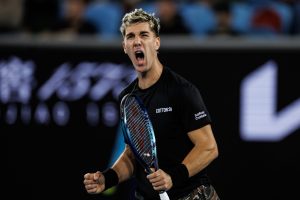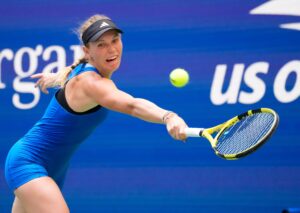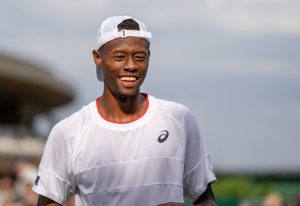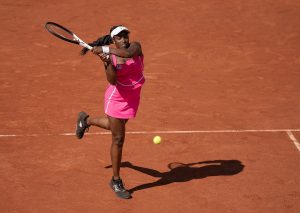Last year, Grigor Dimitrov beat David Goffin in three excellent sets to win the ATP Finals. Though the match lacked the star wattage of some recent finals, with 2016 pitting World #1 Andy Murray against World #2 Novak Djokovic, the quality of tennis from Dimitrov and Goffin was worthy of the occasion. When Dimitrov at last wrapped up the 7-5 4-6 6-3 win thanks to a Goffin volley that found the net instead of the court, he fell to the floor overcome by the emotion of the moment.
All week, he had played the sort of tennis he had long been thought to be capable of, but had so rarely delivered on. Dimitrov’s scrambling defence had kept him alive in points even when under heavy pressure and he had shown the killer instinct to step in and finish opponents when he was in the ascendancy. His forehand was firing, with his ability to use it effectively when stretched out wide on the run particularly notable.
His first serve was earning him free points and his second serve, often fragile, held up well under some stern examinations. Even his backhand, the Achilles’ heel that had been his undoing so many times, proved useful. Dimitrov’s slice kept players from establishing a comfortable rhythm and he spread the court with it superbly. The title took him to a career-high ranking of world #3 and, after also winning the Cincinnati Masters, he looked ready to challenge for the sport’s biggest honours.
Dimitrov doesn’t deliver
Unfortunately, not for the first time, Dimitrov has failed to make good on the gains he made in 2017. Just as he struggled in 2015 after a great 2014, he has struggled for form for the majority of this season. It started promisingly enough at the Australian Open where he made the quarterfinals, though his defeat there to the unseeded Kyle Edmund must have rankled. All the more so after he had played so well to beat Nick Kyrgios in the fourth round.
He followed that quarterfinal run with a good week in Rotterdam where he reached the final. But concerningly, when he came up against Roger Federer there, he seemed frozen in the spotlight. The result was that Federer, merciless as ever, whipped him 6-2 6-2. That defeat looked to have badly dented Dimitrov’s confidence and he followed it with early losses in Dubai, Indian Wells and Miami.
He began the clay court swing, a surface he won just five matches on in 2017, with an impressive semifinal showing in Monte Carlo which he followed by making the quarterfinals in Barcelona. But that was as good as it got for Dimitrov as the early losses began to mount up. They included defeat in the second round to Novak Djokovic on the grass at Queen’s and a woeful first round-loss to Stan Wawrinka in four sets at Wimbledon.
His run to the quarterfinals in Toronto was promising, but the heavy 2-6 2-6 defeat he took at the hands of Kevin Anderson was not. Nor was his loss to Djokovic in the third round in Cincinnati where he was defending champion. At the US Open, he again lost in the first round to Wawrinka, putting in another extremely disappointing performance. At the Laver Cup he lost both of his matches before suffering a three-set defeat to Dusan Lajovic in the second round in Beijing, his most recent outing. (Correction: Dimitrov did win one match at the Laver Cup.)
A write-off the Bulgarian
His latest defeat all but confirms that he will not be in the eight-man field for the ATP Finals. With Nadal, Federer, Djokovic and del Potro already qualified, only four places remain although Nadal’s participation is in doubt due to injury. Even if Nadal does withdraw, Dimitrov would have to make up a gap to John Isner that currently stands at 1,230 points. Though he has narrowed that gap slightly by earning 45 points in Beijing, he is going to need to make far bigger gains than that to stay in contention.
Short of winning in either Shanghai or Paris and collecting some big points elsewhere, Dimitrov will not have the opportunity to defend his ATP Finals title. And deep runs are proving hard to come by for Dimitrov who has not reached a Tour-level semifinal since April. That makes it hard to imagine Dimitrov suddenly finding the sort of exceptional form that would sustain a late challenge for a place in London.
But it is talent he has been he has been unable to harness in recent months. Though there have been a handful of good performances, such as in his victory over Frances Tiafoe in Toronto and in his defeat to Djokovic in Cincinnati, they have been few and far between. The majority of the matches Dimitrov has lost have been the result of his own poor play. Against Wawrinka, he won just one of the eight break points he forced and hit 42 unforced errors and seven double faults.
Dimitrov, who doesn’t have the firepower of a number of his colleagues at the top of the game, cannot afford to be that wasteful. He has also struggled badly at the line. Against Wawrinka, he made just 52% of his first serves and lost 25 of the 43 points he started with his second. Against Lajovic in Beijing, he improved that tally of first serves made to 63% and he won a respectable 71% of the points behind it. But he lost 52% of the points behind his second delivery and that cost him the match.
What’s next?
The one positive for Dimitrov to focus on is that this is not the first time he has experienced a prolonged spell of poor form. He was ranked as low as 40th in the world as recently as August, 2016 and he recovered from that nadir. This year, he looks likely to finish somewhere between 15th and 20th in the rankings. And an added bonus is that he will still be seeded at the Grand Slams after the decision to revert to only 16 seeds was reversed.
He will have a platform to build on. He may also look to a change in coach, with his working relationship with Dani Vallverdu looking increasingly stale. Making a switch in the personnel around him as been rewarding for Dimitrov in the past. It would not be a huge surprise to see him benefit from such a change, even if the improvement in results turns out to be ephemeral again. But unfortunately, finding the answer to the deeper problems in Dimitrov’s game won’t be so easy.
It should be deeply concerning for Dimitrov that after what should have been a breakthrough season, he has not only failed to improve on his gains but in fact failed to at all consolidate them. Having begun the season touted as a possible contender for Major titles, he has instead regressed and may well end his year without any titles at all. Worse still is that Dimitrov, now 27, should be enjoying the best years of his career, the greats are as strong as ever and a raft of new young stars look to be arriving.
The 2018 ATP season may be remembered for many things. It was the year that Federer became the oldest world #1 in history. Nadal won title number 11 at Roland Garros. Djokovic reminded the world what they had been missing in his absence with back-to-back Slams at Wimbledon and the US Open. It was the year of del Potro, Thiem, Tsitsipas and Khachanov. And, if he’s not careful, it could just prove to be the year that Dimitrov faded into irrelevance.
Main Photo:
Embed from Getty Images






